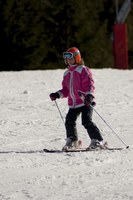Prairie Fare: Ski to Better Health This Winter
(Click an image below to view a high-resolution image that can be downloaded)
By Julie Garden-Robinson, Food and Nutrition Specialist
NDSU Extension Service
“You OK?” my husband asked.
I had taken a tumble on my skis and was lying in a heap on a pile of snow. My pride was injured, but I could see my feet still were attached to my body and I was able to move.
Note to self: Do not try to balance on one slippery cross-country ski while maneuvering the other ski over a chain link barrier. I caught my ski on the chain and flipped myself over the fence. Fortunately, I landed in a layer of soft snow.
I contorted my body enough to get back up and moving on my skis.
Cross-country skiing also is called “Nordic skiing,” referring to the Scandinavian region where skiing is believed to have originated out of necessity. As I slid around the groomed course, without falling, I might add, I felt as though I was getting in touch with my “inner Scandinavian.”
I “awakened” some arm and leg muscles that had been “napping” for a while, too.
My distant European ancestors would not have been lollygagging around a city golf course on their waxless skis. They would have been hunting for dinner, gathering firewood or just moving from point A to point B on their homemade skis. They probably had another stick or two as poles to help propel them. They certainly did not have the fancy ski poles we have available.
In fact, “ski” is from a Norse word for “stick of wood.”
Skiing has many health benefits. Along with strengthening arm and leg muscles, skiing strengthens your heart and lungs. Lifelong skiing and other physical activity just might extend your life.
Researchers at Ball State University, in collaboration with Swedish researchers, compared the long-term effects of skiing on strength and endurance among 80-plus-year-olds who had engaged in lifelong exercise with participants who had engaged in limited exercise.
The group of Swedish participants consisted of endurance athletes, all of whom regularly skied. They even had a former Olympic champion in the mix. The other group was U.S. men of the same age who had not exercised regularly.
Both groups were engaged in various exercise protocols that measured strength and endurance. Not too surprisingly, the 80-year-old lifelong exercisers were in “fantastic shape,” functioning more like 40-year-olds, according to the researchers.
I will keep this study in mind as I build my muscles and capacity to remain upright and perhaps even get onto a more challenging course. We dressed in layers and wore hats, so we didn’t get too cold or too warm.
Fortunately, I remembered to wear some sunblock because we skied for an hour. My Scandinavian bloodline also provides my easily sunburned skin. When your skin is exposed to sun, be sure to wear a broad-spectrum sunscreen with an SPF (sun protection factor) of at least 30. Don’t forget to apply lip balm because the skin on our lips also is vulnerable.
On the way back to our starting point, I took off my skis and slid them under the fence. I had learned my lesson.
When we went inside, I felt quite invigorated and began cleaning a closet. My husband was sitting on the couch pretending to “flail in agony” (his words). He was a little tired by the experience.
Some of his distant ancestors were more likely “Alpine” (downhill) skiers who skied in the Alps. Cross-country skiing is a workout. We will have to find a hill for him to get in touch with his ancestry later this winter.
We all need to take steps to keep moving in all seasons and choose a variety of activities to maintain our strength and endurance. Any amount of physical activity is better than none. Always check with your health-care provider before beginning a new exercise program, though.
Aim for 30 minutes of moderate physical activity on five or more days per week. See https://www.ndsu.edu/boomers and click on “muscles” for links to a variety of information.
Because the cross-country ski trail near us is about two miles around and we spent about an hour skiing, I figure we each burned about 350 to 400 calories on our activity.
When I got inside, I decided that after all the effort, I would not consume the matching amount of calories with a snack. I had a cup of green tea, which is rich in antioxidants. It warmed and hydrated me without any calories.
Because I adopted my “English” last name from my husband, here’s a nod to some of his non-alpine ancestry. In place of a “recipe” this time, here’s how to brew a tasty cup of tea, which has zero calories unless you add cream and sugar.
- Bring freshly drawn water (preferably not softened or hard) to a boil in a glass or enamel container (not aluminum), remove from the heat and cool for one to three minutes.
- Pour the heated water into a teapot made of glass, china or porcelain, then add about 1 teaspoon of tea leaves for every 6 ounces of water. Allow the tea leaves to move freely in the water (referred to as “blossom”) and then strain when poured. If using an infusion basket or tea ball, select one large enough to allow the leaves to move.
- The length of brewing time can affect flavor. Usually steep for three to five minutes. Experiment with the amount of brewing time to get the desired flavor or follow the manufacturer’s directions.
- When time allows, warm the tea cup before serving the tea.
See http://tinyurl.com/teatime-NDSU to view “Take Time for Tea: For Health and Well-being” (FN 1328).
(Julie Garden-Robinson, Ph.D., R.D., L.R.D., is a North Dakota State University Extension Service food and nutrition specialist and professor in the Department of Health, Nutrition and Exercise Sciences.)
NDSU Agriculture Communication - Jan. 7, 2016
| Source: | Julie Garden-Robinson, (701) 231-7187, julie.garden-robinson@ndsu.edu |
|---|---|
| Editor: | Ellen Crawford, (701) 231-5391, ellen.crawford@ndsu.edu |



